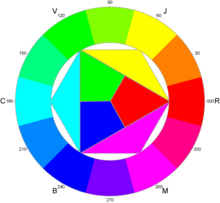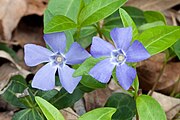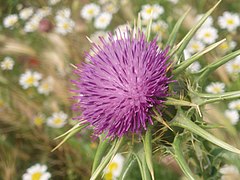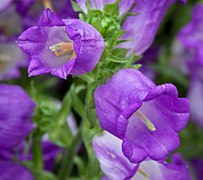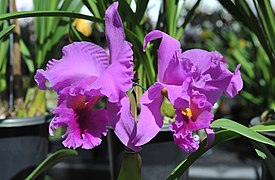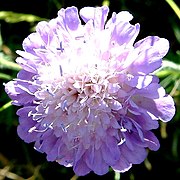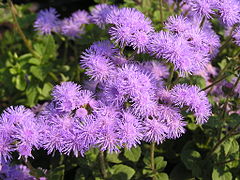violet
color code: # 9932CC
color code: # 8B00FF
color code: # A146FF
Violet is a color stimulus and a spectral color that ranges from the short-wave end of visible light, the limit to the ultraviolet , to around 425 nm or 430 nm.
Light with this property can also be remitted as body color . In normal parlance, the color names violet and lilac are used to cover shades between red and blue, but violet is the “pure” short-wave color stimulus, while purple often describes a broken color in red-blue. The complementary color after subtractive color mixing is yellow , after additive color mixing it is green (where the exact mixture of the respective primary red and blue tone (secondary color ) is referred to as magenta ; violet is thus a tertiary color that is made up of magenta and blue and is complementary to yellow-green ).

Etymology of violet, lavender and magenta
Violet (with minor forms) already appears in German-language painting sources from the 15th to the 16th century as the name of a rather light, pale violet painter's color. In the 17th and 18th centuries violet (adj.) And violet (noun) established themselves as normal color names in German. It is based on French violet (noun) 'violets', also 'violet color , violet' and violet (adj.) ' Violet colored, violet blue', from Latin viola 'violet' (cf. also violaceus 'violet colored'). The most common shade of violets tends to be blue, which is also referred to by the color adjective 'violet blue'.
Also from the French later (2nd half of the 18th century) the sometimes strongly competing color name purple was borrowed. This initially appears as a fashionable textile color in German texts. The French word lilas (pronounced: 'lilá') (= 'lilac' or 'lilac-colored') is of oriental origin (like the plant itself) and comes from Arabic and Persian , probably through Spanish mediation. In addition to white and pink varieties, there is now a wide range of colors for lilacs. The flower colors are violet or lavender and range from dark and saturated to medium purple tones to delicate, pale varieties; blue-violet and red-violet colors emerged.
The color name magenta developed in the 20th century and goes back to the bloody battle of Magenta (1859), a northern Italian city.
Shades in the violet range: differentiation problems
There are several words for the purple hues, which differ slightly in meaning.
- The color purple borders on purple in some older color models .
- Purple is either synonymous with violet or it denotes a broken, lighter violet, so in this case it is not a pure hue and can be achieved by subtractive color mixing with violet and white. Colloquially, however, purple is often used for the shade purple. The lighter, pastel color variant is also (Germanized) called lilac or lilac .
- Magenta lies between purple and red, so it can be understood as a purple or bluish red and as a complementary color to green.
- The fashion color pink is understood in German as a bright, whitened (pastel-toned) magenta, or a strong blue-tinged pink (the English meaning of pink is 'pink'!).
Different color models ( color circles ) make varying use of these color names, the examples show some color names defined for the design of websites .
color code: # FF1493
color code: # 9400D3
color code: # 8B008B
color code: # 800080
Despite the very different impression of the violet hues, the use of the words for this color range is inconsistent and sometimes still controversial. Empirical research has shown that dictionary definitions and official language patterns are not always in line with common usage, and that, for example, purple and purple are often used as synonyms in practice.
To use purple as a color word
In the past, purple things were often classified as blue or red depending on the prevailing color impression.
The word purple is in fibulae often used as the first color name, as the well-known characters are initially limited. This blue-red shade becomes familiar to children and consolidated as a written color concept .
There is a report by Lina Panitz about the officially protected Milka-Lila color brand of the Kraft Group's chocolate products , which has its own Pantone number
Color theory
Spectral violet
The spectral color violet corresponds to a wavelength of 400 to 430 nanometers , i.e. it is at the short-wave end of the visible spectrum. It cannot be displayed with television and computer monitors due to the lack of (sufficiently intense) phosphors . Spectral violet can be seen on a CD, in which a powerful light source is reflected when diffraction occurs on the surface.
- Indigo is an earlier common name for violet and describes the area to blue as a spectral color.
- Pink clearly tends towards red and is on the purple line in the CIE color system . Purple is the mixed color of red and blue colorants, which does not have a spectral color, but which is created by the excitation of blue and red receptors .
- Magenta is a shade from the purple range . At Ostwald , today's magenta of the CMY system is still called “Veil” and is the optimal color that he calls the middle- wrong color because it forms the complementary color to green.
Mixed purple

In the true sense of the word, violet is the name of the spectral color at the short-wave end, which adjoins the indigo and changes into the ultraviolet. Only in this sense is violet a monochromatic spectral color. Purple , on the other hand, is a mixed color and designation of the color valence of red and violet color stimulus. The most intense purple tones form the “ purple line ” of the CIE chromaticity diagram. Purple is the color that belongs to the “royal” dye from the purple snail.
Violet is the color name for the secondary color in the additive color mixing used when the light of the primary color blue with red coincide. Technically, it is better to use the term magenta for this.
The RAL number color catalog has its own color range 4xxx violet , currently from 4001 red lilac to 4005 blue lilac and 4006 traffic purple to color 4010 Telemagenta , the Telekom "Identy Color". In addition, the RAL color 5000 violet blue is included in the blue area.
Dyes
The color violet occurs in nature, so the color tones of the violet and later of the lilac gave the name of the color. For a long time, however, it was not possible to produce a permanent dye, such as is required for dyeing textiles. In ancient times, very expensive dyes extracted from purple snails were used to color luxury items. In the Middle Ages and in the early modern period, purple dyeing of textiles was often achieved by dyeing them twice (with red and blue colorants, e.g. kermes and woad , later madder or koschenille and indigo ). It was only in 1856 that William Henry Perkin accidentally obtained the (ever) first artificially synthesized dye mauvein when he was conducting studies on coal tar. Two years later August Wilhelm von Hofmann succeeded in obtaining the dye fuchsin .
gallery
- Natural shade
Flowering Jacaranda mimosifolia (Australia)
Milk thistle
( sylibum marianum )Bellflower
( Campanula medium )Purple orchid with accents of magenta
Delicate purple flowering
field scabiousCommon Liver Balm
( Ageratum houstonianum )Purple blooming
iris
Violet in everyday life and culture
General symbolism
There are partly contradicting statements about the effect of violet. The hue is considered mysterious and mystical and is associated with faith , spirituality and service. Violet has a calming effect, but also stands for loneliness , melancholy , suffering, sadness and renunciation.
In color counseling it is recommended to express self-confidence and individuality and for all occasions where diplomacy is required. Violet with its shades of color is also considered full of imagination and creative , sensitive, intuitive and extraordinary. It is said to have an aphrodisiac effect.
After the production of the first fabrics with the newly discovered artificial dye between 1858 and 1869, the pale " mauve , or violet colored silk" was considered the fashionable color of the better people.
religion

- In the Christian Church , purple is the liturgical color for Advent and Lent .
- In faith it is the color of reflection, repentance , contemplation and conversion.
- The color often stands for spirituality or the mystical .
- The coloring of the clothing of high Christian dignitaries established the meaning of dignity .
- In the National Socialist concentration camps , the Bible Students imprisoned for their faith (see Jehovah's Witnesses ) were marked with a "purple triangle". The triangle on the top was used to mark opponents of the regime, violet stood for resistance on grounds of belief.
politics
- The party Die Violetten has chosen violet as its eponymous because the party and the color stand for spirituality .
- The pirate party of Austria has the color purple.
- The pan-European party Volt Europa and its national offshoots use purple as a uniform design.
Women's movement
As an expression of love for women and independence (freedom), red-blue colors are mentioned for the first time by the ancient poet Sappho, who lives on the Greek island of Lesbos .
Famous women influenced the fashion world with clothes of this color. In the 19th century the color was rediscovered for the women's movement. Purple as a mixture between pink (female, previously red considered a male color) and light blue (male, previously blue considered a female color) is a symbol of equality between the sexes. The posters for the first International Women's Days were already painted in purple. The color became fashionable in the "golden 1920s," and by the 1970s it was almost a must for feminists to dress in purple. Many women's political projects were given a name that contained the word purple. The “purple dungarees” was literally and often ridiculed.
literature
Alice Walker gave her 1982 autobiographical epistolary novel called The Color Purple (dt. The Color Purple ). He traces the life story of a self-liberating African American woman.
Purple Day
The Purple Day has been held since 2008 annually on 26 March. On this memorial day to educate people about epilepsy , the color is intended to remind of the loneliness of those affected.
See also
Web links
Individual evidence
- ^ Franz Wenzel: AGFA light filter . fotokino-verlag, Halle 1957.
- ↑ a b Das Großes Tafelwerk - collection of formulas for secondary levels I and II, Cornelsen Verlag, p. 112
- ↑ For the history of the word family violet in German, see William Jervis Jones: Historisches Lexikon deutscher Farbbezeichen . Akademie Verlag / De Gruyter, Berlin 2013, under violet .
- ↑ Numerous text references and references to secondary literature in Jones: Historisches Lexikon , under purple .
- ↑ On the problematic color value of purple in older and more recent German sources, see Jones: Historisches Lexikon, under purple.
- ↑ See e.g. B. Yanqian Fan: Color nomenclature in German and Chinese. A contrastive analysis. Lang, Frankfurt / M. 1996 (Diss. Essen 1993/94), pp. 104, 131 f., 140 and 152. On the basis of various recognition and naming tests with her informants, Fan hardly found a difference between violet and lilac referentially , so that both are used as synonymous basic color words in Germans would be considered. See also Hans Altmann: On the semantics of color adjectives in German. In: 'Flu', 'Kamm' and Eulenspiegel. Festschrift for Elmar Seebold on his 65th birthday. Edited by Wolfgang Schindler and Jürgen Untermann. Walter de Gruyter, Berlin, New York 1999, pp. 1–21. Altmann found (p. 13ff.) That the majority of his young informants knew no difference between violet and lavender (here empirically definable as "a rather dark, saturated mixed color"), but at least "the replacement of the older violet by that " was well attested younger purple , which more and more soaks up the scope of meaning of purple ”.
- ↑ The color Milka . In: Die Welt , October 11, 2005
- ↑ a b Color effect ( Memento of the original from December 4, 2011 in the Internet Archive ) Info: The archive link was automatically inserted and not yet checked. Please check the original and archive link according to the instructions and then remove this notice.
- ↑ a b c Irene Dalichow, Mike Booth: Aura-Soma - healing through color, plant and gemstone energy , Knaur / MensSana, 2003, pp. 101-102
- ↑ Godey's Lady's Book and Magazine
- ↑ Ann Buermann Wass: Rivalling nature in the beauty and brilliancy of their coloring: Synthetic dyes and fashionable colors in Godey's Lady's Book and Magazine 1856-1891 , The Chronicle of the Early American Industries Association, December 2000, at findarticles.com
- ↑ Those with the "purple triangle" - Jehovah's Witnesses in the concentration camps
